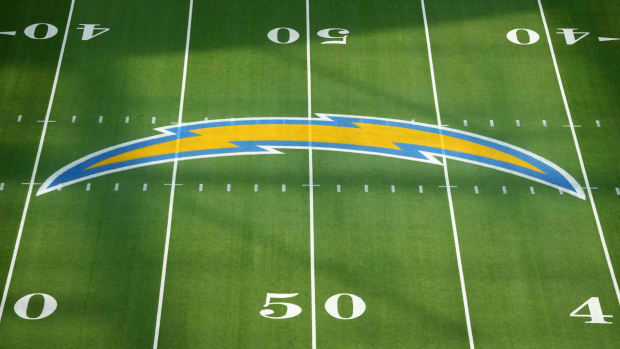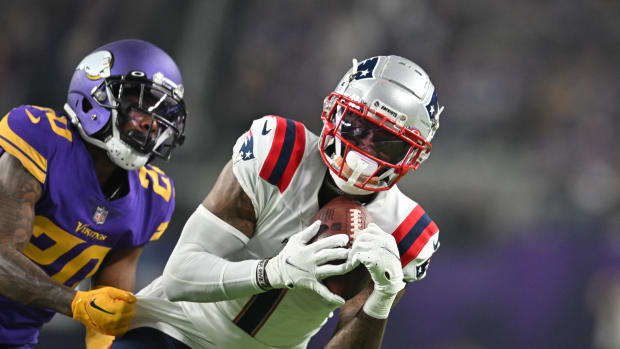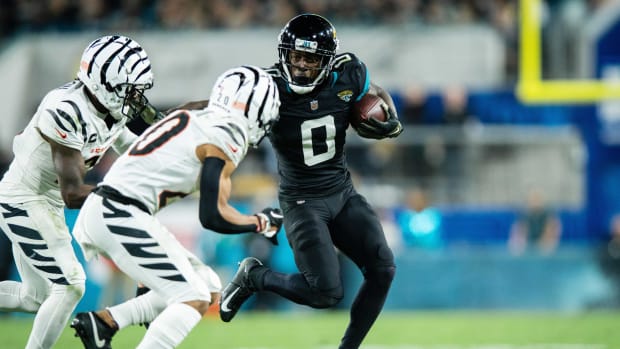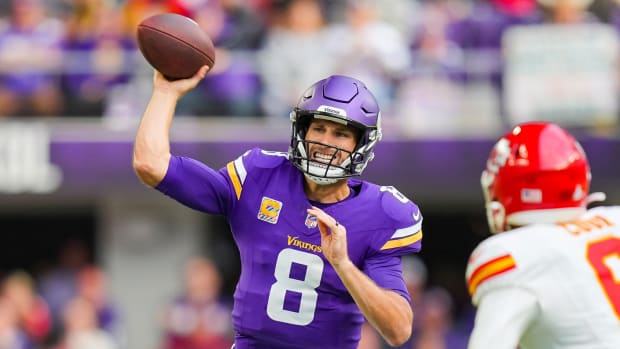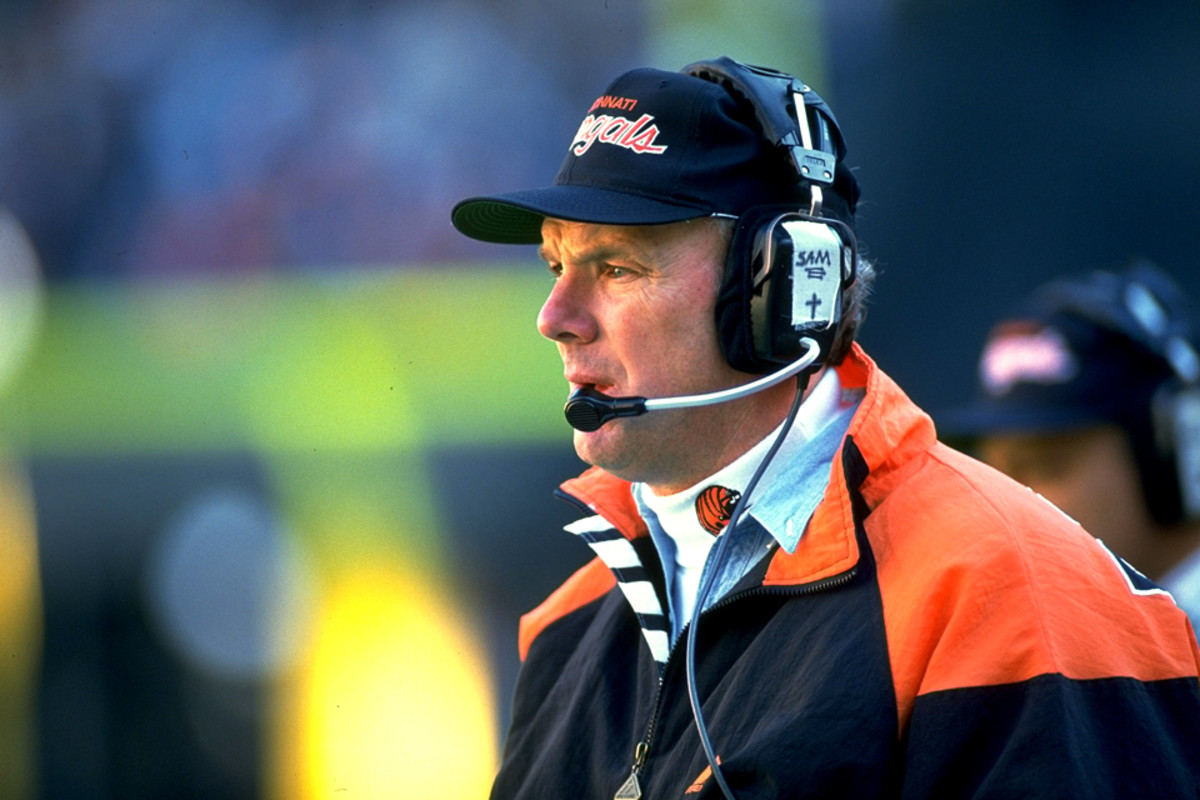
Understanding the NFL’s Code Talkers
The no-huddle offense has been a staple of the playoffs, a part of game plans as much as screen passes and go routes. No one takes more delight in that than Sam Wyche, who introduced the no-huddle to the NFL with his Cincinnati Bengals in the 1980s—often to the scorn of officials and opponents. The scheme goes well beyond professional football. Even Wyche’s grandsons—one is a quarterback for his high school’s JV team in Cincinnati and another for his fifth-grade squad—run the no-huddle. These days, Wyche lives on 28 acres in rural South Carolina, enjoying retirement, he says, with “horses in the pasture and rescue dogs in our laps.” But the onetime NFL quarterback and coach keeps a keen eye on today’s offenses. In the run-up to this weekend’s championship games, he talked to The MMQB about sugar huddles, the Patriots’ latest offensive trickery and “New York Bozo.”
VRENTAS: Do you feel proud seeing how prevalent the no-huddle offense has become 30 years after your Bengals teams used it?
WYCHE: There’s always tinkering and tweaking. Another coach has a new idea, and usually makes it even better. But the original concept was, when you go to a new team [as a coach], you generally have a team that’s not very good, or they wouldn’t have fired the coach in front of you. So you are rebuilding for a year. Part of getting off to a good start is trying to bring better teams down to your level. I left the 49ers after the ’82 season, and in 1983, I was the head coach of Indiana University. Indiana was rebuilding, and that’s where the no-huddle idea came to be. We were not going to beat Michigan and Ohio State unless we could snooker ’em some way. We said, “Why don’t we just wear ’em out? We’ll play against a tired Ohio State team, instead of a fresh one.” And then with Cincinnati, we just kept on going. It wasn’t to sell more tickets, which a lot of people accused me of. The no-huddle is a strategy, like having two tight ends, or sending a guy in motion, or shifting, or going to a five wide receiver set with one quarterback and no blockers.
VRENTAS: How similar is the tempo of offenses being run now compared to the way you used the no-huddle back in the 1980s?
WYCHE: Teams are now staying with the fast tempo for longer. Originally we did it to change the tempo. We would go fast and then slow it down, then we would go fast, fast, fast for a couple—and then slow it down so they didn’t know what was coming. Then we decided we’ve got to be careful that when we slow it down, they don’t get fresh people in, so we came up with what we called “set alerts.” If the defense tries to substitute, we yell, “Set alert!” That meant we’re going to get to the line, the ball is coming up quick, and we’re running a play that we had memorized. We would catch them with too many men on the field, which you still see happen.
The matchups that will make or break the conference championship games I’m not Russell Wilson, but I play him onTVWhy Rex Ryan makes sense for the BillsThe man who can change WashingtonThe sun has not yet set on Peyton ManningA football Sunday with Richard ShermanAaron Rodgers’ Starr momentIs there a franchise QB in the 2015 draft?
Follow The MMQB on Facebook, Twitter and Instagram.
The crowd has been educated to make a lot of noise, so [players] can’t hear what [the quarterback is] saying. We went to what we called the “sugar huddle.” The name simply came from one day when I said, “Let’s get up there, and we don’t have to have a real huddle. You guys kind of cuddle up there within a yard, a yard and a half of the line, listen to the quarterback, and he will yell it out.” Nobody can hear on the other side anyway, thanks to their crowd, and we’ll just call it the cuddle huddle. They didn’t go for that one. We decided to call it the sugar huddle instead, which was a colloquialism from the South, meaning you sugar up to your girlfriend, you kind of snuggle up and get up close to her. It became the sugar. So we would get in the sugar, we’d huddle up real tight, and then the learning curve kicked up again. We said, “Why would we go back eight yards at any time? What genius decided you have to run eight yards from the huddle to the line of scrimmage? Why don’t we just stand two yards away? If they try to substitute, we yell, 'set alert,' and we’re ready to go just as fast as we were if we were if in the no-huddle.” So that’s what I see happening now. I see the sugar. I even hear commentators refer to it as the sugar huddle, not even explaining what it truly is, but they’ve heard it obviously from their interviews with coaches and players before the game. I see it with the visiting team, at some point, during virtually every game.
VRENTAS: The Packers and the Patriots, who play this weekend, have used the no-huddle very prominently in recent years. Which offenses stand out to you the most when you’re watching?
WYCHE: The Eagles were fun to watch. I thought that was most reminiscent of what we did. With Denver, of course, you had the coach [Peyton Manning] out there standing in the middle of the field. Both the Packers and the Patriots, to begin with, they’ve got field generals. I always thought Boomer Esiason was just a tremendous commander on the field. You’ve got to have somebody who really takes charge; really, all the teams left in the playoffs have that person at the helm. Once you have that, you have to have players who are smart enough to take instructions that are abbreviated in code, maybe half-heard. You need a lot of what I call big-time pros. Not little-time pros. The teams that have been together longer—the Patriots, Green Bay, all those teams that have been together longer—their odds go up by two or three percentage points. If their tempo is good, and they don’t make mistakes, they can go up another couple of percentage points. Pretty soon you’re up to where you’ve got about a five to an eight percent edge on your opponent by the end of the game. And unless you turn the ball over, you’re going to win with that. But all these teams are left are all good teams. We’re looking at only the strong ones here.
I tell you what I see as a terrible installation, in my view, of the no-huddle. That’s where every lineman, every back, every receiver, they all turn and look to the sideline to get their call. One coach is telling the linemen what to do, and so forth. They can’t snap the ball, because they’re all standing up in an illegal formation. And as a result, you are not burning up any energy for the defense. Part of what I would tell the offensive linemen is that if you don’t see the whites of the defensive lineman’s knuckles when he gets into a three-point stance, then he’s not burning up any energy. If you’re in your starting stance, you’re burning up energy. But if a team—like I see a lot of pro and college teams doing—is just standing and reading the sideline, you might as well go back in the huddle. You’re giving them extra recovery time. I want to snap the ball before they recover from the previous play.
VRENTAS: Do you think today’s no-huddle is as much a thorn in the side of defensive coaches as it was in the ’80s?
WYCHE: I won’t tell you which defensive coach this is, but here’s a story. I was at a golf tournament last year, and we were riding back on the bus, on the “celebrity bus.” (I had to get a special pass, by the way, because I wasn’t a real celebrity.) The bus was taking us back to the hotel, and a defensive coordinator in the NFL started telling me how much he hated the no-huddle. Going on and on. We were just talking football, and that just pushed his buttons right then. He said, “I hate this thing. I don’t know why in the world we allow it.” That’s what I heard for five straight years when we were putting it in, starting in 1984. And then after we went to the Super Bowl in ’88, everybody started taking a peek at it, which is the way it is. The winning teams get studied more, and a lot of what they do is copied. When he got through, I never did say a word. I know some of the other coaches who were sitting around, by the expressions on their faces, by the little smile on the corners of their mouths, they realized that he didn’t know I was involved in putting it in at the beginning of it all. He was really hammering me, but I was very cool, which is out of my character. I am not very cool.
VRENTAS: The Patriots caught the Ravens off-guard last week with a creative formation, lining up a running back as an ineligible receiver and putting an eligible receiver at left tackle who caught a 14-yard pass. Your thoughts on that bit of trickery?
WYCHE: I did see that. I think the officials, at that point, should have stepped in and given the defense time to react. When you yell as they break the huddle who is eligible or ineligible, not everyone is going to hear that. When something like that happens late, and the defense has not had a chance to hear an official, that’s a technique officials need to polish up on. He had probably never seen that before, either. So I don’t blame the official.
Now, let me tell you, I could write a half a book on just what we went through [with the officials] in those five years [of introducing the no-huddle]. We had umpires who would pick the ball up, put it behind their back and not let us snap the ball. We are standing there in position ready to go, and they wouldn’t let us snap the ball until the defense gave them the nod, “OK, we are all set.” The offense dictates the tempo of the game. Not the umpire, not the TV for commercials, not the defense. But now they have rules in place they didn’t have before, about substitutions, to give the defense a chance to match up; the officials will make sure you can’t snap the ball until the subs have a chance to get in and settle in, which I think is good. That’s a good rule. I’m all for it. But when you didn’t have that rule, there wasn’t any sense in making up your own rules to defeat our strategy.
The key to doing that, getting creative with formations and personnel, is having the right players. Do you have a player that can line up and block like a tight end and then split out and run a route? He’s gotta be able to run a route that gets him open and have the speed to pull away from a defender. In Cincinnati, we were lucky. At running back, for instance, we had a kid named James Brooks from Auburn. He was as good a wide receiver as he was a running back; he was great. And we had a tight end named Rodney Holman, from Tulane, who was as good a wide receiver as he was a tight end. If you’ve got players like that, where they are almost utility players, where they can play two positions and do it well, yeah, you can mix it up much better than your opponent.
VRENTAS: One of Aaron Rodgers’ calls at the line last week raised some eyebrows: “New York Bozo.” As someone who had his quarterbacks speak in code at the line for years, did you get a kick out of that?
WYCHE: I did laugh. My wife was on the computer, and I think she noticed that I looked over at her to see if she had caught that. It was pretty funny. There were some hilarious things along the way that the quarterback would say or do when we ran the no-huddle—sometimes it was a signal that had absolutely no meaning. And if you caught it on tape it was funny. We used “booger” a lot; "booger" didn’t mean anything. Booger is something you don’t want to have anyway. I remember that one passed through for a short time.
Way back in the ’80s, we tried to let the players come up with the names of plays. Basically, with no-huddle you give up the privacy of the huddle. You let the defense listen in on the call, only you talk in code words they don’t understand. You speak in a different language, and they don’t know what “pirate, trigger, Bruce” means. Everybody’s got their own words. For us, if it was a sweep, wide play, we decided to have nautical terms. These were the three nautical words the team came up with: pirate, Popeye and sailor. So it told me immediately what they did on Saturday mornings: watched TV cartoons. So pirate means we’re going to run a sweep; trigger is an ‘R’ sound, we’re going to the right; Bruce is the code word for ‘boss,’ blocking back on the strong safety. The players decided to call it Bruce, because Bruce Springsteen was the boss in the mid ’80s. I thought they would call it “Sam,” but my name didn’t come up. Then we later added another name, because we used it a lot, and we added the word Paul, because Paul Brown was the ultimate boss there. So we would say, trigger or bully if we were going to the right or to the left, or river or lake, or any ‘R’- and ‘L’-sounding words you can think of.
When I heard “New York Bozo” I figured that was a bogus call. New York probably meant to the right; we’re going to run to the right, or we’re going to slide the line to the right, if it was pass protection. “Bozo New York,” that means, what I am about to say after “bozo’ is bogus, just a funny call. We would have calls that were bogus, and then we had key calls. After you heard “yellow,” for example, the next thing was live. Everything up until that point was bogus. Boomer yelled any kind of crazy thing out. Some of it, we were nervous the boom mike was going to pick up and they’d have to have a seven-second delay watching the game on TV.
VRENTAS: Are you still coaching the no-huddle as a volunteer at Pickens High School in South Carolina?
WYCHE: I did not coach this past year, because my grandson, Sammy, was the quarterback of the JV team at Moeller High School in Cincinnati, which is big-time high school football in Ohio. And my next grandson, Jack, was the quarterback on the fifth-grade team, so we’d catch both games. And both of them run the no-huddle, all the way from youth football up through high school. They run it in spurts, more like we did when we first started out. We would come out, normal, normal, then bam, all of a sudden, it was coming at them before they knew what hit them.
Follow The MMQB on Facebook, Twitter and Instagram.
[widget widget_name="SI Newsletter Widget”]











































